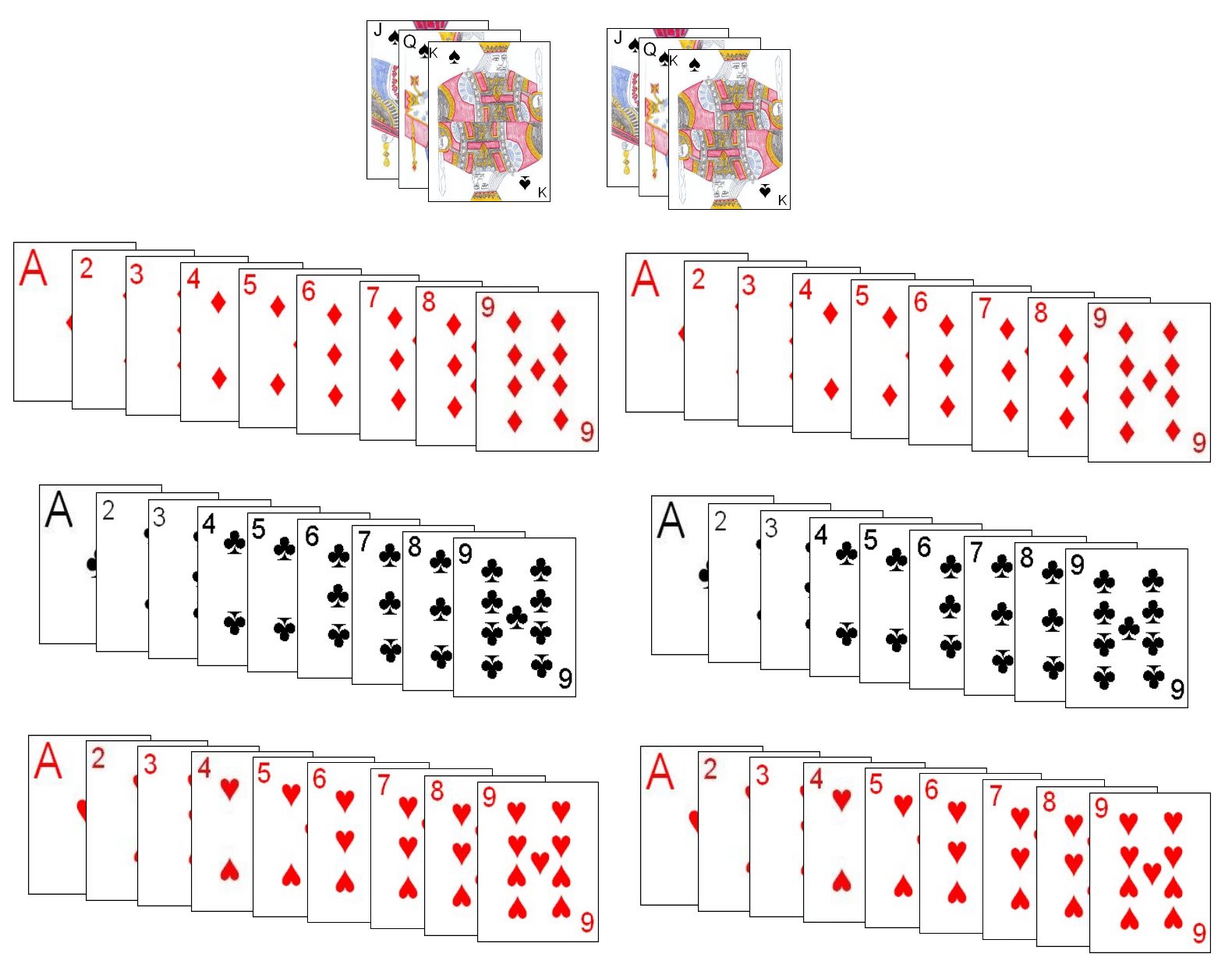 The deck used for this game is highly unusual, but can be easily created from two standard 52 card decks. To create this deck, retain all the cards in the ranks Ace, 2, 3, 4, 5, 6, 7, 8, 9 in the suit of Clubs, Hearts, and Diamonds, setting the other cards of these denominations aside as they will not be used. In addition, add the cards of rank Jack, Queen and King from the suit of Spades, discarding the remaining cards in this suit. This should result in a special deck consisting of 60 total cards. The ranking of these cards are as follows (from high to low); 9, 8, 7, 6, 5, 4, 3, 2, Ace. The court cards (Jack, Queen, King) have a special purpose in the game which will be described further below.
The deck used for this game is highly unusual, but can be easily created from two standard 52 card decks. To create this deck, retain all the cards in the ranks Ace, 2, 3, 4, 5, 6, 7, 8, 9 in the suit of Clubs, Hearts, and Diamonds, setting the other cards of these denominations aside as they will not be used. In addition, add the cards of rank Jack, Queen and King from the suit of Spades, discarding the remaining cards in this suit. This should result in a special deck consisting of 60 total cards. The ranking of these cards are as follows (from high to low); 9, 8, 7, 6, 5, 4, 3, 2, Ace. The court cards (Jack, Queen, King) have a special purpose in the game which will be described further below.
Determination of seating positions and first dealer can be performed in a variety of ways, with drawing for high cards a common method. Using this method, each player should draw a card from the shuffled, face-down deck. The player drawing the highest card would have first choice of seat, the next highest the next choice of seats and so on. The player drawing the highest card of all would be set as the first dealer.
Scoring in this game is recorded using chips or tokens. Thus, before the start of the game each player should be provided with an equal number of such chips. Often, for convenience, multiple colors are used with each player given a certain number of each, such as the following (10 white, 5 blue and 5 red). In this scheme, 10 white chips is equivalent to 1 blue chip, and five blue chips is equivalent to one red chip.
Once the players are seated and the first dealer determined, this player should thoroughly shuffle the cards and offer it to the player at his right to cut. After the cut, the dealer completes and the cut and begins the deal. The cards are dealt in a clockwise direction around the table, in small face-down packets to each player. The number of cards dealt is dependent on the number of participants, as per the following chart:
|
For a game with 2 or 3 players, the dealer deals the cards in 2 card packets, with 4 or 5 players, the dealer serves the cards in packets consists of 3 cards each.
The player to the immediate left of the dealer has the first play and the turns rotate around the table in a clockwise direction from player to player. The first player begins by playing any legal combination to the table from his hand (the legal combinations are described below). Each other player in turn then must also play to the table. He must play an equal number of cards as played by the leader to the trick. A player may play to the trick using any cards from his hand, but if possible, a player will attempt to play a higher such combination in order to be a contender for the trick. The following chart shows the possible combinations in this game:
| Combination | Description | How to Rank | Example |
|---|---|---|---|
| Single Card - Ace to 9 | Any one card of rank Ace to 9, from the player's hand. | The highest ranked card (in the usual ranking order) of the suit originally led to the trick wins the trick. Cards of other suits or court cards cannot win the trick. If there is a tie for the highest card of the suit led, the first of these cards played to this trick is considered to have won the trick. | 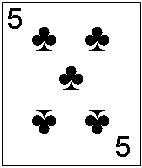 |
| Single Court Card | Any one court card from the player's hand. | If every player plays a court card to the trick, the leader to the trick wins the trick. Otherwise, the first non-court card played to the trick sets the suit, and the highest card of that suit played to the trick wins the trick. If there is a tie for the highest card of that suit played to the trick, the first of the tying cards wins the trick. | 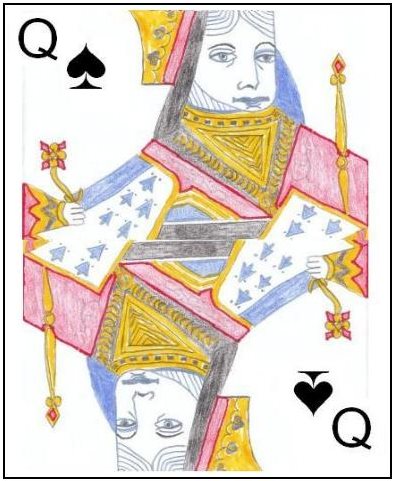 |
| Sequence | Three or more cards in sequence, all of the same suit. Court cards cannot be played as part of a sequence. | The highest sequence, consisting of the same number of cards wins the trick. The cards do not have to be in the same suit as that of the first sequence led to the trick, but all the cards in that sequence must be of the same suit. The sequence consisting of the highest ranked cards wins the trick. For two equally ranked sequences, the first played is considered the higher. | 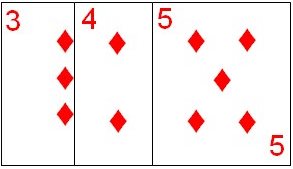 |
| Group | Three or more cards all of the same rank. However, there must be at least one card in each of the three suits, Hearts, Diamonds and Clubs. Court cards cannot be played as part of a group. | The group consisting of the highest ranked cards would win the trick. However, in order to be a contender for the trick, the group must consist of the same number of cards as led to the trick and have one card from each of the suits, Hearts, Diamonds and Clubs. For two groups of the same ranking, the first played is considered the higher. | 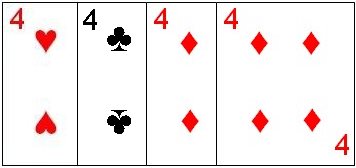 |
| Ace Group | Three or more Aces, in which each of the suits Hearts, Diamonds and Clubs must be represented by at least one Ace. In addition, with a group of Aces, the player can add as many court cards to the lead as he wants. | Each face card added to the trick by the leader is considered to be of the same denomination as the Group (Aces), thus, in order to beat this combination a player must play a number of cards, all of which must be of the same (but higher) rank, equal to the total number of cards led to this trick. | 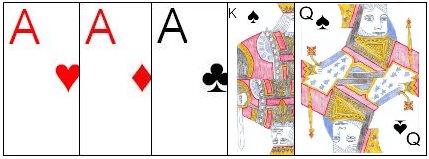 |
The winner of each trick is the player who plays the highest combination of the same type as originally led to the trick, and this winning player is credited with winning a certain number of points based on the number of cards led to the trick. For example, winning a trick in which a sequence of three cards was led, would earn that player three points (also called tricks). The winner of each trick leads the first card or cards to begin the next trick. The game continues until all cards have been played, after which the hand is scored.
At the completion of each hand, the players count the number of "tricks" (or points) he has won, as mentioned above. Each player, except for the player who has won the most points during the hand, loses a number of penalty points. This number is equal to the number of "tricks" that player has won, subtracted from the number of "tricks" won by the player winning the most tricks during the hand. These penalty points are provided by that player placing the designated number of penalty chips into a common pile of chips in the center of the table. If multiple players tie for the most "tricks" won during the hand, none of those tying players are required to lose any penalty chips.
After this, the players then determine if they were able to win a certain number of tricks, which wins the game. The following chart shows the number of points which a player must win during a hand to win the game, based on the number of players in the game:
| Number of Players | Tricks Needed to Win Game |
|---|---|
| 2 | 11 or More |
| 3 | 9 or More |
| 4 | 8 or More |